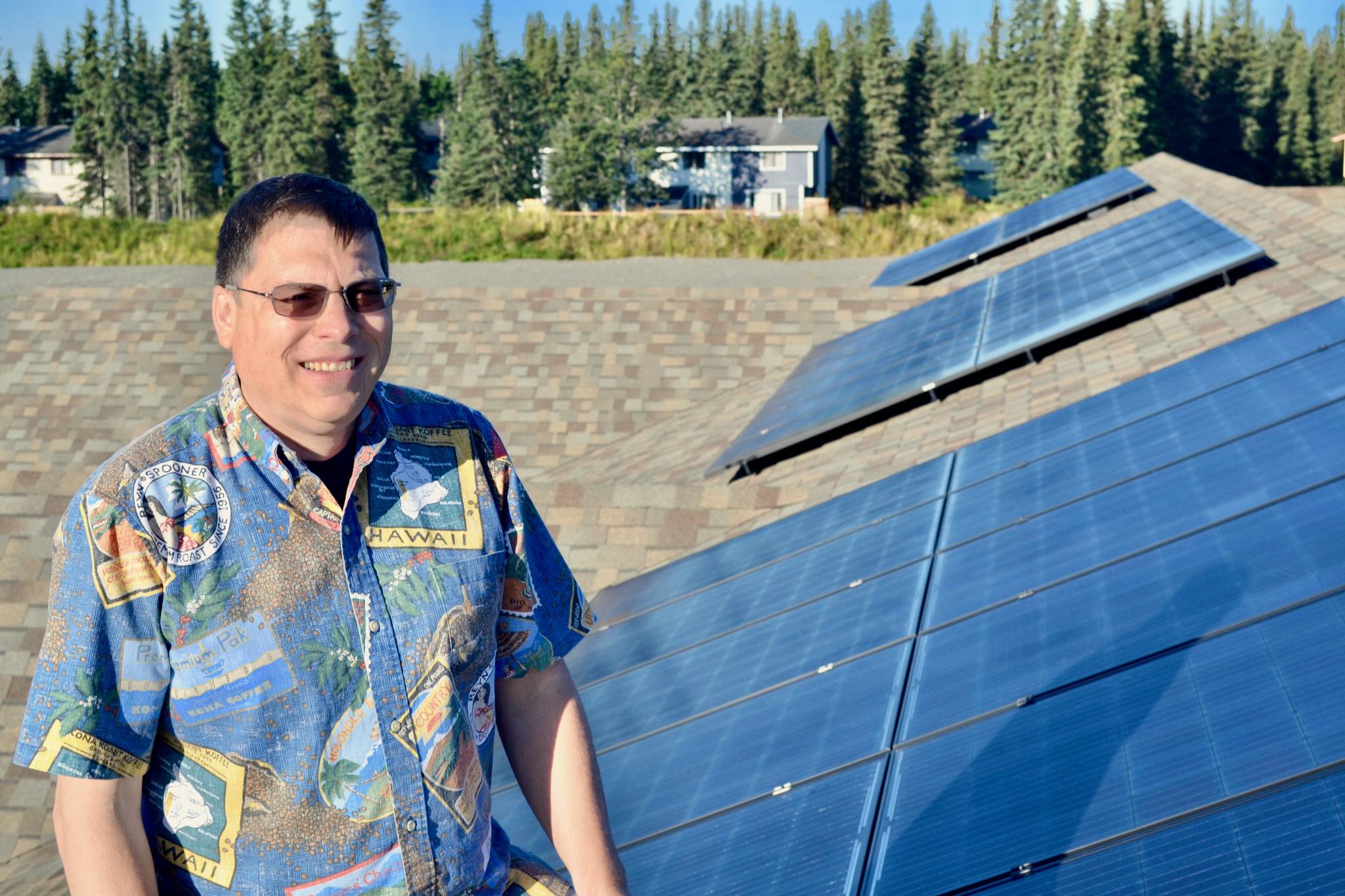Stephen Trimble wants everyone to know that the business of solar power is growing. His company, Arctic Solar Ventures Corporation, has been installing more and more solar panels on the central peninsula.
In 2016, when Trimble’s company first started, it put up around 120 panels. In 2017 that number ticked up to set more than 1,000, and so far this year they have already surpassed a thousand.
‘We’ve seen a huge uptick in volume,” Trimble said. “There’s a lot of different tangible outcomes that come from solar.”
One of Arctic Solar Ventures’ recent customers is Dale Bagley, one of the owners of Redoubt Realty. On July 14, he installed 48 panels on the Redoubt Realty building on Kalifornsky Beach Road. He said he was interested in solar power because of the cost savings. The panels cost him a total of $50,000, but he’s expecting to save over $3,000 a year.
Bagley was awarded a $13,800 grant to help pay for the cost of the panels on his commercial property. He says there’s a lot of tax benefits and government rebates for those interested in getting into solar.
“I can’t say I ever thought two hoots about doing solar,” Bagley said. “I was never part of that group, but now I’m in it for the savings perspective.”
On an average day, Bagley’s building uses roughly 50-kilowatt hours, which is the total amount of energy used in an hour of time. So far, his best day for solar energy production has been 100-kilowatt hours, which is twice as much energy as he needs. The excess energy can’t be stored, and it goes back into the grid to help power neighboring buildings. Bagley then receives credit on his electricity bill for the energy he put back on to the grid.
When Bagley was first looking into solar, one of his biggest worries was how clunky chrome and flashy equipment on the roof of his building would look, he said. However, Arctic Solar Ventures uses a matte black set up to attract the sun and the heat. This is most useful in the wintertime when snowfall might cover the panels.
“All the panels are black with black hardware,” Trimble said. “(The panel) absorbs more heat to help melt the snow off of them. Also, building the panels vertically gets rid of the snow problem.”
Trimble said one of the biggest myths about solar power in Alaska is panels don’t work well in the cold.
“Our seasons have changed quite a bit and there’s less snow on the ground, which has improved viability for solar,” Trimble said. “Solar panels produce more electricity the colder it gets. In places like Arizona, where people think solar can crank for days, they get damaged by the heat. Colder air is a secret advantage we have.”
Voltage levels and the value of solar power is diminished in the darker months of December and January, Trimble said.
Though interest in solar energy has been gaining traction recently, it’s not brand new. Anchorage-based renewable energy company Lime Solar, which was founded in 2013, maintains an office in Homer. Soldotna-area contractor Gary Dawkins has been installing wind turbines and solar panels for 28 years for a variety of homes and businesses, including some on the remote west side of Cook Inlet. For the last four years, the city of Seward and the Seward Sustainable Energy Group have hosted a Seward Energy Forum and Fair focusing on renewable energy sources — including solar —in Alaska.
The Kenai National Wildlife Refuge’s new visitor center has been investing in solar power since it first opened its doors in May 2015. The center uses a pair of 60 square meter solar arrays, which are expected to provide between 3 and 10 percent of the headquarters building’s power with more during summer months.
On a community level, there’s new potential for solar power. Homer Electric Association has been seriously looking into solar power over the last year. Bruce Shelley, director of member relations at HEA, said awarding the contract for the community solar project, which would be Alaska’s highest-capacity solar farm, was brought to a standstill with a tie vote at HEA’s March 12 board meeting. The proposed solar farm would be positioned at HEA’s Anchor Point substation and would take place through a purchase tower agreement, which means a contractor provides a bid to build an 800,000-watt system, and HEA purchases the power from it.
However, Shelley said HEA isn’t done yet. After HEA’s annual meeting on May 3, a member survey, which asks for a $10 pledge of support, has been distributed as a way to gauge interest in introducing solar power.
“We’ve been encouraging members to make pledges, and so far almost 50 people have signed up and have pledged,” Shelley said. “We are pushing it hard.”
In the fall, the board members will vote again if they want to award a contract for the solar project.
Also on July 14, borough assembly member and owner of Alaska Cab Brent Hibbert had Arctic Solar Ventures place 30 panels on his home. He said solar power could help him become more self-sufficient and that he’s already noticed a difference.
“I hope (solar power) is growing,” he said. “It’s a little expensive to get into, but it pays for itself.”
Reach Victoria Petersen at vpetersen@peninsulaclarion.com.
